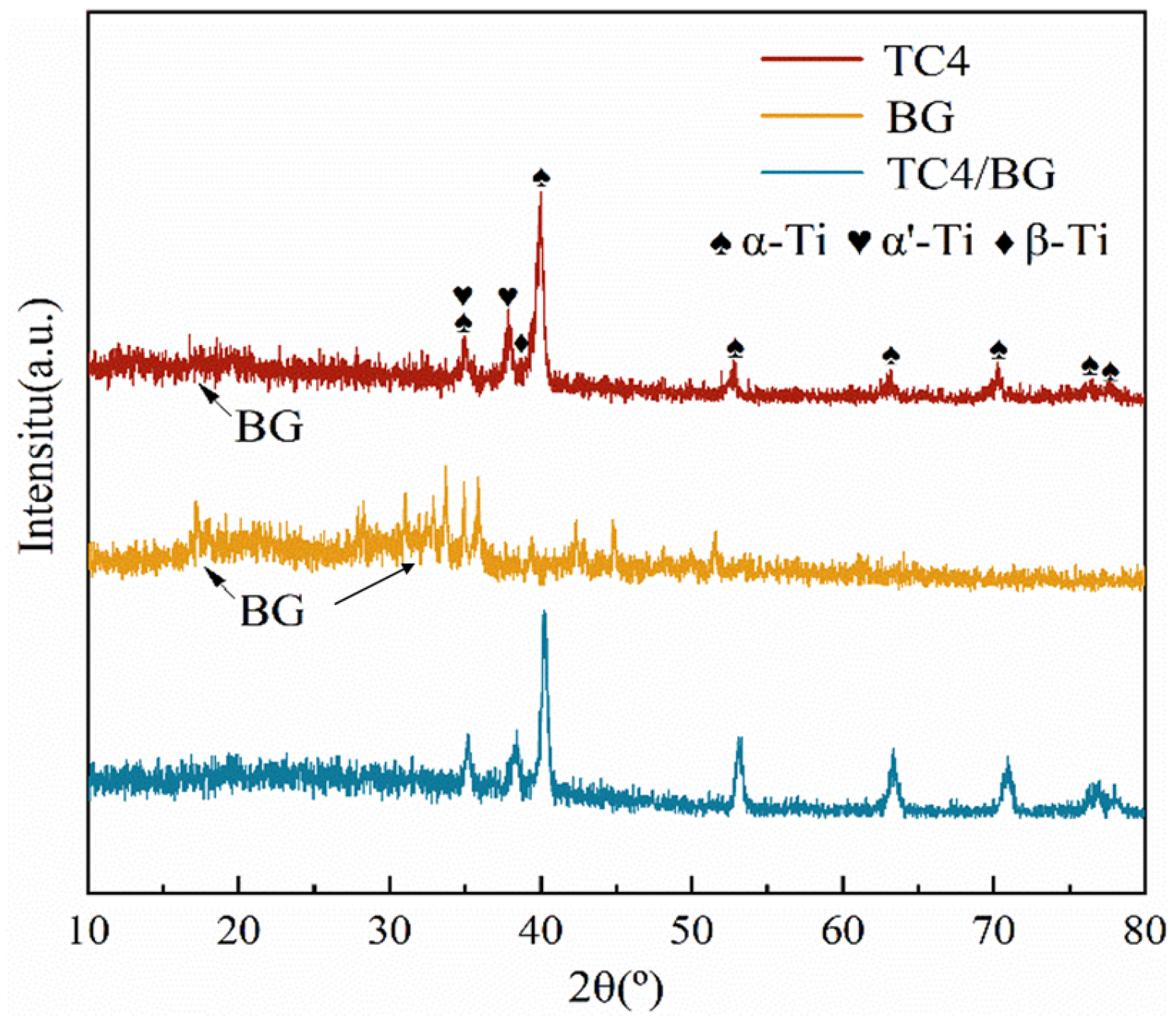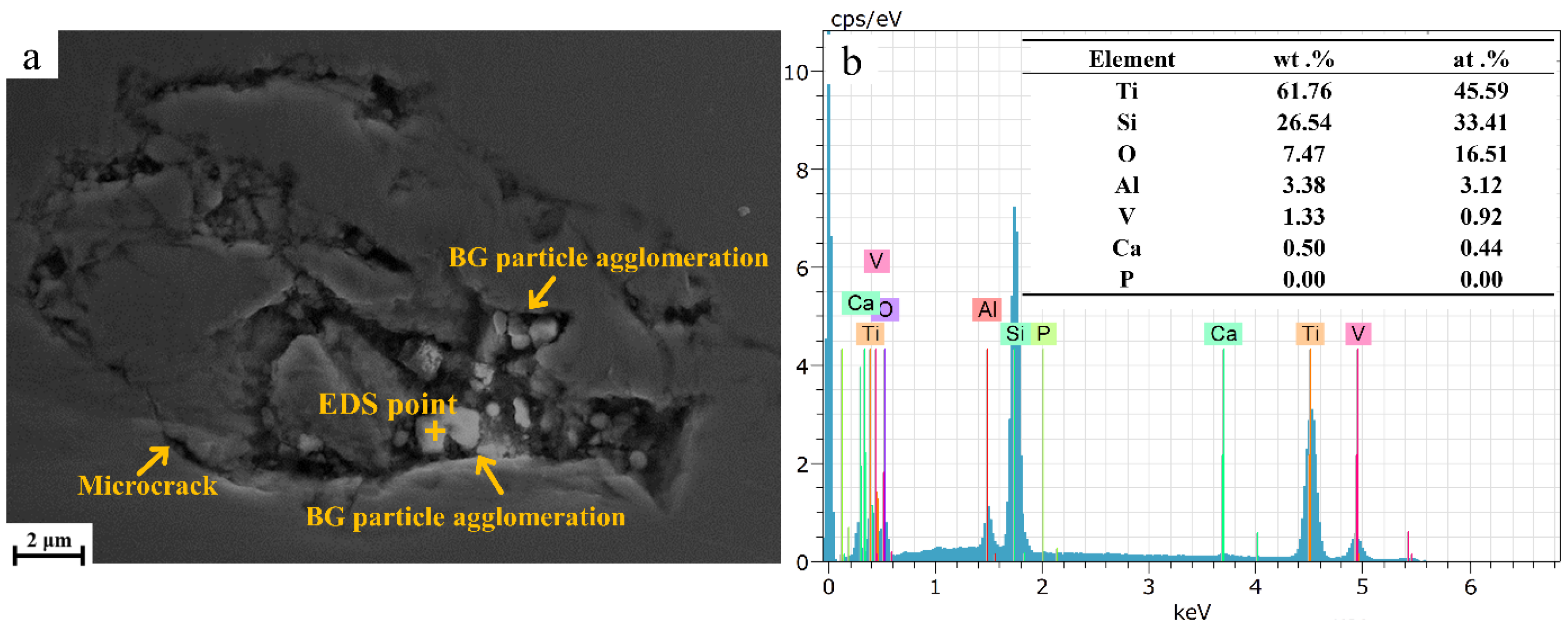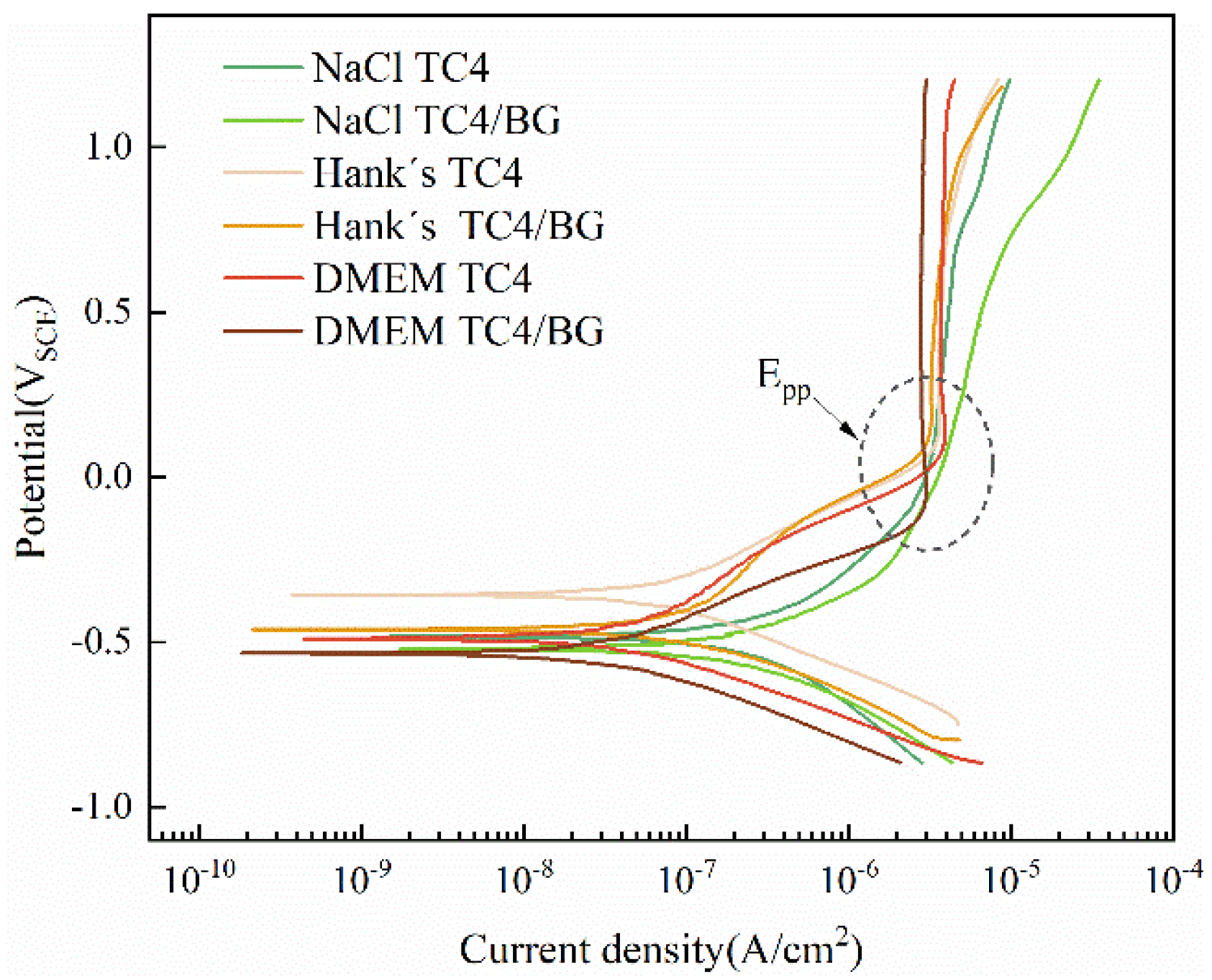Influence of Bioactive Glass Addition on TC4 Laser Cladding Coatings: Microstructure and Electrochemical Properties
Abstract
:1. Introduction
2. Materials and Methods
2.1. Materials
2.2. Coating Preparation
2.3. Characterization Methods
3. Results and Discussion
3.1. Composition and Microstructure of Composite Coatings
3.2. Electrochemical Behavior of TC4/BG Composite Coatings
4. Conclusions
Author Contributions
Funding
Institutional Review Board Statement
Informed Consent Statement
Data Availability Statement
Conflicts of Interest
Abbreviations
| Bioactive glass | (BG) |
| Charge transfer resistance of the dense barrier layer | (Rb) |
| Charge transfer resistance of the porous layer | (Rp) |
| Constant phase angle element | (CPE) |
| Constant phase angle element of the dense barrier layer | (Qb) |
| Constant phase angle element of the porous layer | (Qp) |
| Corrosion current density | (Icorr) |
| Dulbecco’s modified Eagle medium | (DMEM) |
| Electrochemical impedance spectroscopy | (EIS) |
| Electrolyte resistance | (Rs) |
| Heat-affected zone | (HAZ) |
| Open circuit potential | (OCP) |
| Passivation current density | (Ipp) |
| Scanning electron microscopy | (SEM) |
| Solidification rate | (R) |
| Temperature gradient | (G) |
| Ti-6Al-4V | (TC4) |
| X-ray diffraction | (XRD) |
References
- Alabort, E.; Barba, D.; Shagiev, M.R.; Murzinova, M.A.; Galeyev, R.M.; Valiakhmetov, O.R.; Aletdinov, A.F.; Reed, R.C. Alloys-by-Design: Application to Titanium Alloys for Optimal Superplasticity. Acta Mater. 2019, 178, 275–287. [Google Scholar] [CrossRef]
- Liu, Z.; He, B.; Lyu, T.; Zou, Y. A Review on Additive Manufacturing of Titanium Alloys for Aerospace Applications: Directed Energy Deposition and Beyond Ti-6Al-4V. JOM 2021, 73, 1804–1818. [Google Scholar] [CrossRef]
- Niinomi, M. Design and Development of Metallic Biomaterials with Biological and Mechanical Biocompatibility. J. Biomed. Mater. Res. Part A 2019, 107, 944–954. [Google Scholar] [CrossRef] [PubMed]
- Chen, Q.; Thouas, G.A. Metallic Implant Biomaterials. Mater. Sci. Eng. R Rep. 2015, 87, 1–57. [Google Scholar] [CrossRef]
- Jiang, P.F.; Nie, M.H.; Teng, J.Z.; Wang, X.B.; Liu, C.Z.; Zhang, Z.H. Multi-Wire Arc Additive Manufacturing of TC4/Nb Bionic Layered Heterogeneous Alloy: Microstructure Evolution and Mechanical Properties. Mater. Sci. Eng. A 2023, 874, 145076. [Google Scholar] [CrossRef]
- Kurup, A.; Dhatrak, P.; Khasnis, N. Surface Modification Techniques of Titanium and Titanium Alloys for Biomedical Dental Applications: A Review. Mater. Today Proc. 2021, 39, 84–90. [Google Scholar] [CrossRef]
- Bao, Y.; Wang, W.; Cui, W.; Qin, G. Corrosion Resistance and Antibacterial Activity of Ti-N-O Coatings Deposited on Dental Titanium Alloy. Surf. Coat. Technol. 2021, 419, 127296. [Google Scholar] [CrossRef]
- Wang, J.; Pan, Y.; Feng, R.; Cui, H.; Gong, B.; Zhang, L.; Gao, Z.; Cui, X.; Zhang, H.; Jia, Z. Effect of Electrolyte Composition on the Microstructure and Bio-Corrosion Behavior of Micro-Arc Oxidized Coatings on Biomedical Ti6Al4V Alloy. J. Mater. Res. Technol. 2020, 9, 1477–1490. [Google Scholar] [CrossRef]
- Han, X.; Ma, J.; Tian, A.; Wang, Y.; Li, Y.; Dong, B.; Tong, X.; Ma, X. Surface Modification Techniques of Titanium and Titanium Alloys for Biomedical Orthopaedics Applications: A Review. Colloids Surf. B Biointerfaces 2023, 227, 113339. [Google Scholar] [CrossRef]
- Raut, H.K.; Das, R.; Liu, Z.; Liu, X.; Ramakrishna, S. Biocompatibility of Biomaterials for Tissue Regeneration or Replacement. Biotechnol. J. 2020, 15, 2000160. [Google Scholar] [CrossRef]
- Wang, C.; Wang, Y.; Bao, Z.; Dong, J.; Geng, Y.; Liu, S.; Wang, C.; Nie, P. Characterization of Microstructure and Mechanical Properties of Titanium -Based Bioactive Ceramics Laser-Deposited on Titanium Alloy. Ceram. Int. 2022, 48, 28678–28691. [Google Scholar] [CrossRef]
- Wu, B.; Xiong, S.; Guo, Y.; Chen, Y.; Huang, P.; Yang, B. Tooth-Colored Bioactive Titanium Alloy Prepared with Anodic Oxidation Method for Dental Implant Application. Mater. Lett. 2019, 248, 134–137. [Google Scholar] [CrossRef]
- Muthaiah, V.M.S.; Indrakumar, S.; Suwas, S.; Chatterjee, K. Surface Engineering of Additively Manufactured Titanium Alloys for Enhanced Clinical Performance of Biomedical Implants: A Review of Recent Developments. Bioprinting 2022, 25, e00180. [Google Scholar] [CrossRef]
- Sivaranjani, S.; Anusha Thampi, V.V.; Shalini, M.; Krishnakumar, G.S.; Veerapandian, M.; Shtansky, D.; Subramanian, B. Imparting Bioactivity to CP−Titanium with Sputtered TiBN Interlayer and Electrophoretically Grown Bioglass Overlay. Mater. Chem. Phys. 2023, 298, 127420. [Google Scholar] [CrossRef]
- Deng, C.; Wang, Y.; Zhang, Y.; Gao, J. In Situ Laser Coating of Calcium Phosphate on TC4 Surface for Enhancing Bioactivity. J. Iron Steel Res. Int. 2007, 14, 73–78. [Google Scholar] [CrossRef]
- Leilei, Z.; Hejun, L.; Kezhi, L.; Shouyang, Z.; Qiangang, F.; Yulei, Z.; Shoujie, L. Double-Layer TC4/Sr Substituted Hydroxyapatite Bioactive Coating for Carbon/Carbon Composites. Ceram. Int. 2015, 41, 427–435. [Google Scholar] [CrossRef]
- Li, R.; Ying, B.; Wei, Y.; Xing, H.; Qin, Y.; Li, D. Comparative Evaluation of Sr-Incorporated Calcium Phosphate and Calcium Silicate as Bioactive Osteogenesis Coating Orthopedics Applications. Colloids Surf. A Physicochem. Eng. Asp. 2020, 600, 124834. [Google Scholar] [CrossRef]
- Zeimaran, E.; Pourshahrestani, S.; Fathi, A.; bin Razak, N.A.A.; Kadri, N.A.; Sheikhi, A.; Baino, F. Advances in Bioactive Glass-Containing Injectable Hydrogel Biomaterials for Tissue Regeneration. Acta Biomater. 2021, 136, 1–36. [Google Scholar] [CrossRef]
- Simila, H.O.; Boccaccini, A.R. Sol-Gel Bioactive Glass Containing Biomaterials for Restorative Dentistry: A Review. Dent. Mater. 2022, 38, 725–747. [Google Scholar] [CrossRef]
- Patel, K.D.; Buitrago, J.O.; Parthiban, S.P.; Lee, J.-H.; Singh, R.K.; Knowles, J.C.; Kim, H.-W. Combined Effects of Nanoroughness and Ions Produced by Electrodeposition of Mesoporous Bioglass Nanoparticle for Bone Regeneration. ACS Appl. Bio Mater. 2019, 2, 5190–5203. [Google Scholar] [CrossRef]
- Patel, K.D.; El-Fiqi, A.; Lee, H.-Y.K.; Singh, R.; Kim, D.-A.; Lee, H.-H.; Kim, H.-K. Chitosan–Nanobioactive Glass Electrophoretic Coatings with Bone Regenerative and Drug Delivering Potential. J. Mater. Chem. 2012, 22, 24945–24956. [Google Scholar] [CrossRef]
- Yang, Y.; Zheng, K.; Liang, R.; Mainka, A.; Taccardi, N.; Roether, J.A.; Detsch, R.; Goldmann, W.H.; Virtanen, S.; Boccaccini, A.R. Cu-Releasing Bioactive Glass/Polycaprolactone Coating on Mg with Antibacterial and Anticorrosive Properties for Bone Tissue Engineering. Biomed. Mater. 2017, 13, 015001. [Google Scholar] [CrossRef] [PubMed]
- Zheng, K.; Lu, M.; Rutkowski, B.; Dai, X.; Yang, Y.; Taccardi, N.; Stachewicz, U.; Czyrska-Filemonowicz, A.; Hüser, N.; Boccaccini, A.R. ZnO Quantum Dots Modified Bioactive Glass Nanoparticles with PH-Sensitive Release of Zn Ions, Fluorescence, Antibacterial and Osteogenic Properties. J. Mater. Chem. B 2016, 4, 7936–7949. [Google Scholar] [CrossRef] [PubMed]
- Liu, Y.; Li, J.; Xu, Q.; Zhang, Y.; Yan, X.; Chen, Y.; He, H. Microstructure and Wear Behavior of TC4 Laser Cladding Modified via SiC and MoS2. Coatings 2022, 12, 792. [Google Scholar] [CrossRef]
- Wan, S.; Cui, X.; Jin, G.; Ma, J.; Yang, Y.; Liu, K.; Li, J.; Wang, S.; Wang, J. Microstructure and Properties Characterization of Laser-Cladded CuAl Alloy Coatings on MgLi Alloy. Surf. Coat. Technol. 2023, 460, 129430. [Google Scholar] [CrossRef]
- Zhao, H.; Yu, C.; Liu, Z.; Liu, C.; Zhan, Y. A Novel Finite Element Method for Simulating Residual Stress of TC4 Alloy Produced by Laser Additive Manufacturing. Opt. Laser Technol. 2023, 157, 108765. [Google Scholar] [CrossRef]
- Ma, J.; Wang, C.Z.; Ban, C.L.; Chen, C.Z.; Zhang, H.M. Pulsed Laser Deposition of Magnesium-Containing Bioactive Glass Film on Porous Ti–6Al–4V Substrate Pretreated by Micro-Arc Oxidation. Vacuum 2016, 125, 48–55. [Google Scholar] [CrossRef]
- Laser Cladding and Laser Direct Glass Deposition of Bioactive Glass and Glass-Ceramics—Bioactive Glasses and Glass-Ceramics: Fundamentals and Applications—Wiley Online Library. Available online: https://onlinelibrary.wiley.com/doi/abs/10.1002/9781119724193.ch14 (accessed on 22 July 2023).
- Gu, H.; Zhang, G.; Cai, E.; Tang, G.; Liu, Q. Bioactivity and Biocompatibility of Porous Gradient Bioceramic Coating Prepared via Laser Cladding Process. Surf. Coat. Technol. 2021, 426, 127800. [Google Scholar] [CrossRef]
- Ghaebi Panah, N.; Atkin, R.; Sercombe, T.B. Bioactivity and Biodegradability of High Temperature Sintered 58S Ceramics. J. Eur. Ceram. Soc. 2022, 42, 3614–3623. [Google Scholar] [CrossRef]
- Huang, Y.; Zeng, X.; Hu, Q.; Zhou, S. Microstructure and Interface Interaction in Laser Induction Hybrid Cladding of Ni-Based Coating. Appl. Surf. Sci. 2009, 255, 3940–3945. [Google Scholar] [CrossRef]
- Zhou, Z.; Li, H.; Liu, Y.; Niu, T.; Li, H. Effect of Ti on the Corrosion Behavior of (FeCrCoNi)100−xTix Alloy. Corros. Sci. 2022, 209, 110807. [Google Scholar] [CrossRef]
- Ji, P.F.; Li, B.; Chen, B.H.; Wang, F.; Ma, W.; Zhang, X.Y.; Ma, M.Z.; Liu, R.P. Effect of Nb Addition on the Stability and Biological Corrosion Resistance of Ti-Zr Alloy Passivation Films. Corros. Sci. 2020, 170, 108696. [Google Scholar] [CrossRef]
- Radu, M.M.; Becherescu, N.; Spătaru, T.; Osiceanu, P.; Mihai, M.A.; Calderon-Moreno, J.M.; Spătaru, N.; Fujishima, A. Improved Suitability as Catalyst Support and More Efficient Charge Carrier Separation of Native Air-Formed TiO2 Films by Mild Laser Treatment. J. Power Sources 2019, 437, 226921. [Google Scholar] [CrossRef]
- Spataru, T.; Mihai, M.A.; Preda, L.; Marcu, M.; Radu, M.M.; Becherescu, N.D.; Velea, A.; Zaki, M.Y.; Udrea, R.; Satulu, V.; et al. Enhanced Photoelectrochemical Activity of WO3-Decorated Native Titania Films by Mild Laser Treatment. Appl. Surf. Sci. 2022, 596, 153682. [Google Scholar] [CrossRef]
- Khan, M.A.; Williams, R.L.; Williams, D.F. The Corrosion Behaviour of Ti–6Al–4V, Ti–6Al–7Nb and Ti–13Nb–13Zr in Protein Solutions. Biomaterials 1999, 20, 631–637. [Google Scholar] [CrossRef] [PubMed]
- Li, Z.; Wang, J.; Dong, Y.; Xu, D.; Zhang, X.; Wu, J.; Gu, T.; Wang, F. Synergistic Effect of Chloride Ion and Shewanella Algae Accelerates the Corrosion of Ti-6Al-4V Alloy. J. Mater. Sci. Technol. 2021, 71, 177–185. [Google Scholar] [CrossRef]
- Fekry, A.M. The Influence of Chloride and Sulphate Ions on the Corrosion Behavior of Ti and Ti-6Al-4V Alloy in Oxalic Acid. Electrochim. Acta 2009, 54, 3480–3489. [Google Scholar] [CrossRef]
- Bai, C.; Li, P.; Gang, T.; Li, J.; Wei, M.; Huang, Y.; Chen, L. Influence of Processing Technology on Electrochemical Corrosion Behavior of Ti-6Al-4V Alloys. Corrosion 2021, 77, 402–412. [Google Scholar] [CrossRef]
- Mehdipour, M.; Afshar, A.; Mohebali, M. Electrophoretic Deposition of Bioactive Glass Coating on 316L Stainless Steel and Electrochemical Behavior Study. Appl. Surf. Sci. 2012, 258, 9832–9839. [Google Scholar] [CrossRef]
- de Assis, S.L.; Wolynec, S.; Costa, I. Corrosion Characterization of Titanium Alloys by Electrochemical Techniques. Electrochim. Acta 2006, 51, 1815–1819. [Google Scholar] [CrossRef]
- Bins-Ely, L.; Cesca, K.; Souza, F.S.; Porto, L.; Spinelli, A.; Magini, R.; Henriques, B.; Souza, J.C.M. On the Increase of the Chemical Reactivity of Cp Titanium and Ti6Al4V at Low Electrical Current in a Protein-Rich Medium. Biomed. Phys. Eng. Express 2018, 5, 015014. [Google Scholar] [CrossRef]
- Monticelli, C.; Zucchi, F.; Tampieri, A. Triboelectrochemical Behaviour of a Si3N4–TiN Ceramic Composite and a Titanium Alloy Commonly Used in Biomedical Applications. Wear 2009, 266, 327–336. [Google Scholar] [CrossRef]
- Guo, S.; Lu, Y.; Wu, S.; Liu, L.; He, M.; Zhao, C.; Gan, Y.; Lin, J.; Luo, J.; Xu, X.; et al. Preliminary Study on the Corrosion Resistance, Antibacterial Activity and Cytotoxicity of Selective-Laser-Melted Ti6Al4V-XCu Alloys. Mater. Sci. Eng. C 2017, 72, 631–640. [Google Scholar] [CrossRef]
- Wang, Z.B.; Hu, H.X.; Liu, C.B.; Zheng, Y.G. The Effect of Fluoride Ions on the Corrosion Behavior of Pure Titanium in 0.05M Sulfuric Acid. Electrochim. Acta 2014, 135, 526–535. [Google Scholar] [CrossRef]
- Tamilselvi, S.; Raman, V.; Rajendran, N. Corrosion Behaviour of Ti–6Al–7Nb and Ti–6Al–4V ELI Alloys in the Simulated Body Fluid Solution by Electrochemical Impedance Spectroscopy. Electrochim. Acta 2006, 52, 839–846. [Google Scholar] [CrossRef]






| Elements | Al | V | Fe | C | N | H | O | Ti |
|---|---|---|---|---|---|---|---|---|
| Wt% | 6.1~6.09 | 4.1~3.9 | 0.12~0.11 | 0.01~0.009 | 0.001 | 0.012~0.002 | 0.147~0.13 | Bal. |
| Elements | Al | V | Fe | C | N | H | O | Ti |
|---|---|---|---|---|---|---|---|---|
| wt% | 6.36 | 4.01 | 0.180 | 0.01 | 0.01 | 0.002 | 0.10 | Bal. |
| Composites | CaO | SiO2 | P2O5 |
|---|---|---|---|
| wt% | 49 | 45 | 6 |
| Composition | NaCl | KCl | CaCl2 | NaHCO3 | NaH2PO4·2H2O | MgCl2·6H2O | KH2PO4 |
|---|---|---|---|---|---|---|---|
| Concertation (g/L) | 8.0 | 0.4 | 0.14 | 0.35 | 0.06 | 0.10 | 0.6 |
| Composition | NaCl | KCl | CaCl2 | NaHCO3 | NaH2PO4 (Anhydrous) | MgSO4 (Anhydrous) | Amino Acids | D-Glucose |
|---|---|---|---|---|---|---|---|---|
| Concertation (g/L) | 6.4 | 0.4 | 0.2 | 3.7 | 0.109 | 0.09767 | 1.60539 | 4.5 |
| Ecorr/VSCE | Icorr/(A·cm−2) | Epp/VSCE | Ipp/(A·cm−2) | |
|---|---|---|---|---|
| NaCl TC4 | −0.487 | 1.37 × 10−7 | −0.005 | 2.96 × 10−6 |
| Hank’s TC4 | −0.360 | 5.72 × 10−8 | 0.110 | 3.51 × 10−6 |
| DMEM TC4 | −0.495 | 3.44 × 10−8 | 0.252 | 3.77 × 10−6 |
| NaCl TC4/BG | −0.513 | 1.15 × 10−7 | −0.023 | 3.41 × 10−6 |
| Hank’s TC4/BG | −0.459 | 5.71 × 10−8 | 0.143 | 3.20 × 10−6 |
| DMEM TC4/BG | −0.532 | 2.61 × 10−8 | 0.126 | 2.87 × 10−6 |
| Equivalent Component | Meaning |
|---|---|
| Rs | Electrolyte resistance |
| Rp | Charge transfer resistance of the porous layer |
| Qp | Constant phase angle element of the porous layer |
| Rb | Charge transfer resistance of the dense barrier layer |
| Qb | Constant phase angle element of the dense barrier layer |
| Rs (Ω·cm2) | Qp-Y0 (Ω−1·cm−2·s−n) | Qp-n | Rp (Ω·cm2) | Qb-Y0 (Ω−1·cm−2·s−n) | Qb-n | Rb (Ω·cm2) | χ2 | |
|---|---|---|---|---|---|---|---|---|
| NaCl TC4 | 8.27 | — | — | — | 32.3 × 10−5 | 0.929 | 2.41 × 105 | 9.76 × 10−4 |
| Hank’s TC4 | 27.7 | — | — | — | 3.09 × 10−5 | 0.873 | 9.56 × 105 | 3.98 × 10−4 |
| DMEM TC4 | 27.7 | — | — | — | 3.98 × 10−5 | 0.859 | 1.79 × 106 | 1.37 × 10−3 |
| NaCl TC4/BG | 3.63 | 1.89 × 10−5 | 0.929 | 123.2 | 1.35 × 10−5 | 0.852 | 4.51 × 105 | 2.33 × 10−4 |
| Hank’s TC4/BG | 17.8 | 3.17 × 10−5 | 0.868 | 238.6 | 2.08 × 10−5 | 0.821 | 9.47 × 105 | 4.45 × 10−4 |
| DMEM TC4/BG | 46.3 | 1.43 × 10−5 | 0.885 | 952.3 | 4.65 × 10−5 | 0.999 | 2.06 × 106 | 2.70 × 10−3 |
Disclaimer/Publisher’s Note: The statements, opinions and data contained in all publications are solely those of the individual author(s) and contributor(s) and not of MDPI and/or the editor(s). MDPI and/or the editor(s) disclaim responsibility for any injury to people or property resulting from any ideas, methods, instructions or products referred to in the content. |
© 2023 by the authors. Licensee MDPI, Basel, Switzerland. This article is an open access article distributed under the terms and conditions of the Creative Commons Attribution (CC BY) license (https://creativecommons.org/licenses/by/4.0/).
Share and Cite
Meng, Y.; Yang, Y.; Zhang, C.; Cui, X.; Liu, E.; Jin, G.; Kang, J.; She, P. Influence of Bioactive Glass Addition on TC4 Laser Cladding Coatings: Microstructure and Electrochemical Properties. Coatings 2023, 13, 1621. https://doi.org/10.3390/coatings13091621
Meng Y, Yang Y, Zhang C, Cui X, Liu E, Jin G, Kang J, She P. Influence of Bioactive Glass Addition on TC4 Laser Cladding Coatings: Microstructure and Electrochemical Properties. Coatings. 2023; 13(9):1621. https://doi.org/10.3390/coatings13091621
Chicago/Turabian StyleMeng, Yao, Yuyun Yang, Changlin Zhang, Xiufang Cui, Erbao Liu, Guo Jin, Jiajie Kang, and Peng She. 2023. "Influence of Bioactive Glass Addition on TC4 Laser Cladding Coatings: Microstructure and Electrochemical Properties" Coatings 13, no. 9: 1621. https://doi.org/10.3390/coatings13091621
APA StyleMeng, Y., Yang, Y., Zhang, C., Cui, X., Liu, E., Jin, G., Kang, J., & She, P. (2023). Influence of Bioactive Glass Addition on TC4 Laser Cladding Coatings: Microstructure and Electrochemical Properties. Coatings, 13(9), 1621. https://doi.org/10.3390/coatings13091621








